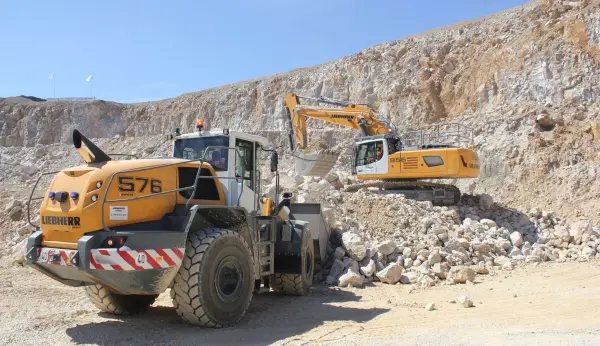A Triumph for Partnership Working

First published in the May 2025 issue of Quarry Management
How Tarmac and the Lower Ure Conservation Trust are restoring Nosterfield Quarry into a wildlife haven
Bitterns are incredibly secretive birds, hiding themselves away in dense reed beds. So, when in the early summer of 2024 several sightings were reported at Nosterfield Quarry, in North Yorkshire, hopes soared that they might be breeding. Were the sightings of adult birds actively looking for fish to feed hungry young?
Eagle-eyed observers kept watch, looking for clues. Days passed, then without warning a young bird flew hesitantly from the reed bed, then another and then a third. But these were not bitterns; they were fledging marsh harriers.
Amazingly, this reed bed, a mere 4ha in size and half a mile from the active workings of Tarmac’s Nosterfield sand and gravel plant, had been home and maternity unit to both of these rare British birds.


It was a triumph for partnership working between Tarmac and the Lower Ure Conservation Trust (LUCT), a charity dedicated to the restoration of quarries into wildlife havens.
It was more than a quarter of a century ago when the two organizations first got together. After exhausting sand and gravel extraction in one part of Nosterfield, Tarmac handed over conservation management to the newly formed LUCT. Volunteers produced scrapes and drains, managed the vegetation, and wildlife – birds, bugs, beetles, and flora – moved in. This part of the nature reserve – all 60ha of it – is now owned by LUCT. With its magnesian limestone and associated aquifers, it has developed into one of the best examples of wetland grassland in North Yorkshire. Lapwing and curlew, both threatened species, breed here. It was the first place in the county where avocet reared young. Seven species of orchid and 40 species of butterfly have been recorded.
More was to follow. By 2003, in a quiet corner of the new quarry site fed by countless springs, LUCT and Tarmac identified an area ripe for development as a reed bed. Tarmac carried out the land profiling, exactly in line with a detailed contour plan, which then delivered the right balance of open water and reed edge.
A bund was created, separating it from an adjoining lake, and sluices were installed to control water-levels. With Tarmac’s job over, LUCT volunteers moved in and over several months planted – by-hand – 28,500 common reeds (Phragmites australis). Otter, water rail, sedge warbler and reed warbler quickly occupied the site and bred.
So successfully did the phragmites generate that, more recently, some of it has had to be cut back, water channels widened, and around 1,000 sedges propagated at LUCT’s own wetland plant nursery, situated at the edge of the quarry, have been planted to improve fish populations. It could not have worked out better for the bitterns and the marsh harriers, as 2024 showed.
According to LUCT director Simon Warwick, who has received an MBE for his conservation work at Nosterfield, it is all down to working in partnership. He said: ‘Yes there are different priorities. Tarmac have a resource to exploit. We have the restoration of the site for wildlife as our aim. Both can be achieved by talking and working together. There is nothing more satisfying than to see big machinery moving in and quarry staff making a difference on a grand scale, to be followed by our great bunch of volunteers building things and planting sedges and grasses.’
Tarmac staff have also helped by coppicing work in adjoining woodland and their expertise was invaluable when an osprey platform and a bat box capable of housing 1,000 inmates were erected (bats moved in quickly, whilst migrating ospreys have used the platform to rest, but so far not be breed, though Tarmac staff and volunteers live in hope).

‘The difference all have made to one area in particular – Flask Lake – in just a handful of years has been nothing short of inspirational,’ continued Mr Warwick. ‘For many years it was a relatively lifeless area of silt and deep water. The edges are now covered in rich wetland planting. These have, in particular, provided a haven for dragonflies which, in turn, are a source of food for birds like the hobby. We can have half a dozen swooping around after prey in the summer, a fantastic spectacle for the 15,000 or so visitors that now come here each year.’
The Well Wetlands nursery
Funded by the National Lottery Heritage Fund, the Well Wetlands project has seen locally collected seeds from nationally rare wetland species nurtured in a commercial-scale, volunteer-run polytunnel.
Reflecting on the project, Emma Higgs, LUCT project manager, said: ‘The restoration of Nosterfield Quarry has provided great opportunities to create new wildlife habitats and enhance biodiversity in the area. The 40ha area now managed by LUCT includes woodland, lakes, and lagoons, as well as priority habitats such as fen, reed bed and magnesian limestone grassland. The site now attracts plenty of wildlife, including lapwing, oystercatcher, bittern, marsh harrier, and little-ringed plover, which all bred last year. The quarry is also home to our plant nursery, which is now producing 20,000 plants per year. Some of these plants, all sourced locally, have been used to create both the fen and magnesian limestone grassland, and we are now providing plants to other restoration projects in North Yorkshire.’

More than 20,000 local-provenance wetland plants involving more than 80 species (some exceptionally rare) are now propagated each year. These include, Great fen-sedge, tufted sedge, purple small-reed, lesser reedmace, purple loosestrife, and water mint.
The nursery is equipped with wet beds and standing areas, producing plants to meet LUCT’s needs as well as supporting habitat restoration projects in the wider Lower Ure Valley landscape. Several rare plants from material of North Yorkshire origin are being cultivated in significant numbers, establishing ex-situ populations which could potentially be used for reintroductions or to reinforce threatened wild populations. These include tufted loosestrife, tubular water-dropwort, marsh pea, fibrous tussock-sedge, and marsh fern. Plants grown in the nursery have transformed former quarry workings into ‘Flasks Fen’ – a habitat that offers shelter and food for a host of wetland birds and invertebrates.
LUCT’s capacity to develop, test and pass-on practical techniques for wetland creation has become an integral part of the work it does. These techniques include: using dead hedging to reduce wave wash; using sacks for safe and efficient planting in shallow water; and specialist propagation techniques for plants such as Great Fen Sedge. Fen creation workshops, plant nursery tours, open days and a wealth of information on LUCT’s website and social media platforms channel enables the charity to share its wealth of expertise and knowledge.


A small organization, LUCT’s achievements are underpinned by its dedicated volunteer team. Some 7,000h of volunteering activity were recorded by LUCT in 2023. Volunteers choose activities to match their interests and abilities, including running the specialist plant nursery, looking after Nosterfield Nature Reserve and outlying sites, and implementing LUCT’s surveying programme, which contributes to national datasets. Volunteers are central to the charity’s community engagement work, leading groups on reserve tours and supporting educational visits.
Mark, a LUCT volunteer, said: ‘I’ve been volunteering here for a couple of years now having spent 37-plus years sat behind a desk. Getting out in the countryside once a week and working amongst the birds and nature throughout the year has really freed my mind.’
LUCT provides volunteers with opportunities to learn new skills, such as plant and aquatic insect identification, and seed collection and propagation. Many are receiving training with certification – for example for driving the charity’s compact tractor, or the use of brush-wood cutters and chainsaws. In November 2024, LUCT volunteers received the Kings Award for Voluntary Service (KAVS), the MBE for volunteer groups, in recognition of their outstanding contribution at Nosterfield Nature Reserve.
Commenting on the recent KAVS Award, Emma Higgs said: ‘We’re absolutely delighted to have received this award and it’s great that the efforts of our volunteers and all their hard work is being recognized.’
Alongside significant improvements for nature, LUCT makes a difference to people. In July 2023, the Lower Ure Conservation Trust was awarded £250,000 from the National Lottery Heritage Fund for a new project: ‘Ure Connected – Engaging People with Nature in the Lower Ure Valley’. The aim of the project is to benefit wildlife along with the communities that live nearby, encouraging people to help bring these habitats to life and give them a stake in a better, more diverse natural world.

Weekend community work days are offered for people unable to take part in LUCT’s regular, weekday volunteer programme. Conservation club enables young people aged 14-18 to help with practical conservation management, such as hedgelaying and dead-hedging, planting, helping to survey butterflies, and identifying moths.

Caitlyn, another LUCT volunteer, said: ‘I started with the conservation club initially, which was just one Saturday every couple of months and I really enjoyed that so I carried it on to Friday once a week. I really enjoy being out in nature doing something physical as an activity and additionally the practical skills that gives you. Everyone here is so knowledgeable.’


Events such as butterfly walks, outdoor yoga, monthly well-being walks, and pond dipping have seen local people of all ages engaging with nature and connecting with the site in different ways.
Two local groups from the charity ‘Dementia Forward’ visit the reserve throughout the year, helping with planting, doing woodland work, and going on nature walks. Local schools, home education groups, and Scout groups have all taken part in activities such as pond dipping, outdoor art, and making bird feeders.
To find out more, visit: www.luct.org.uk
Subscribe to Quarry Management, the monthly journal for the mineral products industry, to read articles before they appear on Agg-Net.com








